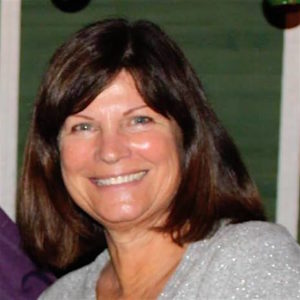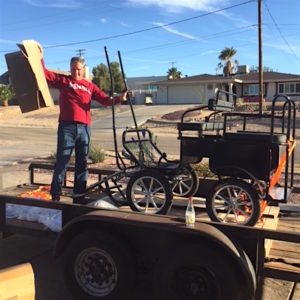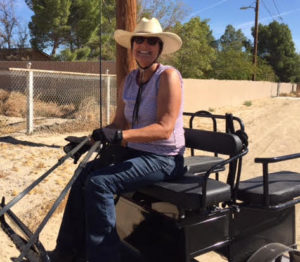Editor’s Note: In the third installment of a multi-part series, we hear from Jeanette Hayhurst, a long-time and avid horsewoman from Barstow, California. Like many of us, she has continued to connect with horses, even when her age and physical limitations kept her from doing a lot of riding. Kudos, Jeanette!
 She writes of her transition from riding to driving and owning a miniature horse. This month, she will participate in her second Death Valley drive with two miniature horses.
She writes of her transition from riding to driving and owning a miniature horse. This month, she will participate in her second Death Valley drive with two miniature horses.
Enjoy this multi-part series.
By Jeanette Hayhurst
That night I joined the corral group for their meeting and pot luck dinner. They opened the sign-ups for the Death Valley drive. After seeing how well Danny did that day, I was confident he could handle it.

Haflingers in a 3-up.
Corral 14 had permission from the Park Service to bring up to 13 wagons as well as outriders. In order to secure my place I signed up and paid my money that night. Since Danny and I drove at the back of the wagon train I didn’t get to talk to the people in the other wagons during the day. At the meeting, I learned Danny and I were a topic of conversation since there were a few that had doubts about how a mini horse would do on the drive. But Danny impressed them and that day they nick-named him the “Chihuahua.” Later, I found out that Corral 14 was originally a Shetland Pony Club and it was Shetland Ponies that were used on the Club’s first Death Valley wagon drive back in the 1960’s.
We were committed. I continued to drive and condition Danny for Death Valley which was less than two months away. By this time I had decided that eventually I wanted to drive a pair and I had bought a second mini. (This new one wasn’t trained to drive, but that’s another story.)
I knew I would need a four-wheeled cart if I was going to drive a pair, so I went ahead and ordered one. I did my research and ended up buying an “entry level” wagonette. It arrived a few weeks before Death Valley. The new wagon was only about 75 pounds heavier than my cart. Because it had four wheels it wouldn’t put weight on Danny’s back and it certainly would be more comfortable for me, so I thought maybe I would take it instead. I hooked Danny up to the wagonette and we started practicing with it. It had brakes which slows the vehicle when going down hill but they were pretty easy to figure out. After a few test runs I decided to take the wagonette to Death Valley.

Unpacking the new wagonette
The home stretch.
Since you can’t take hay into Death Valley I needed to make sure Danny would eat pellets. Everyone suggested soaking them to help keep him hydrated and avoid colic. I discovered that the “certified weed free pellets” that you are required to use quickly turn to mush when you add water, but Danny didn’t seem to mind and slurped them right up.
It was time to pack for trip. We would be gone a total of eight days. I had lists for everything. All my feed and personal stuff would be placed in the support truck so I had to limit what I took. The wagons all hauled their own bedding, clothes, and food. The outriders and I couldn’t haul our own stuff so it all went in the support truck.
They did encourage me to bring my guitar so that was my bonus item. The weather was pretty warm, but I heard that the year before it was so cold that the horses’ water buckets froze at night. I brought layers of clothes and a heavy jacket, just in case. Danny was starting to get his winter coat but I decided against shaving him in case it got cold.

Practicing with her new four-wheel wagonette
There were four of us ladies going from Barstow including me, two outriders and one support truck driver. Between us we also brought a camp stove, cooking utensils, cases of drinking water, and food for the week. And just in case one of the horses got sick, we also had about every horse drug and remedy we could possibly need.
The time had come.
I was about to find out if I had prepared myself and my little horse for a five-day, 60-mile wagon train trip through Death Valley!
Whoa….this is so fascinating, exciting, and scary to read about. I’m on the edge of my seat waiting for the next installment. You go girl!!!